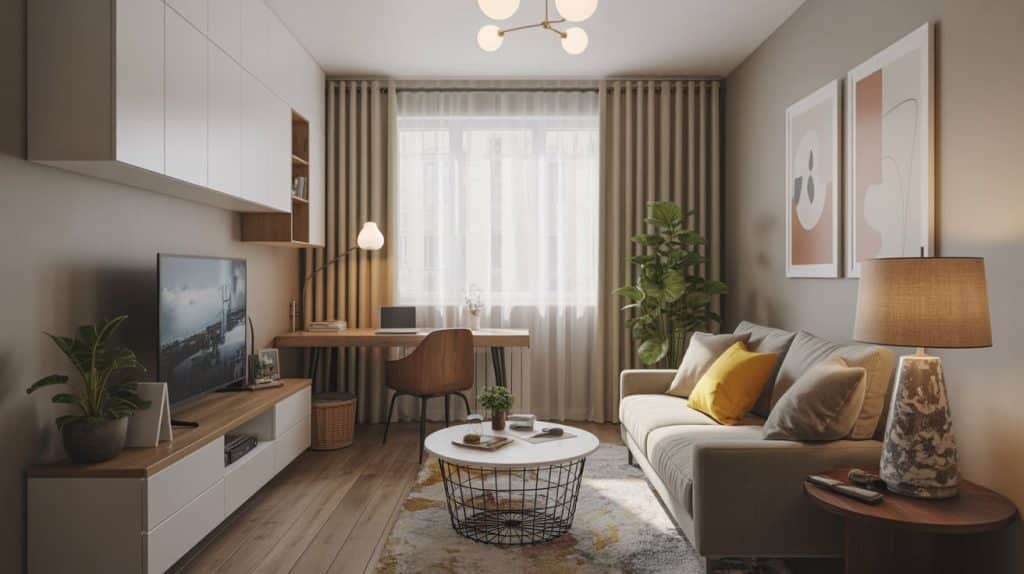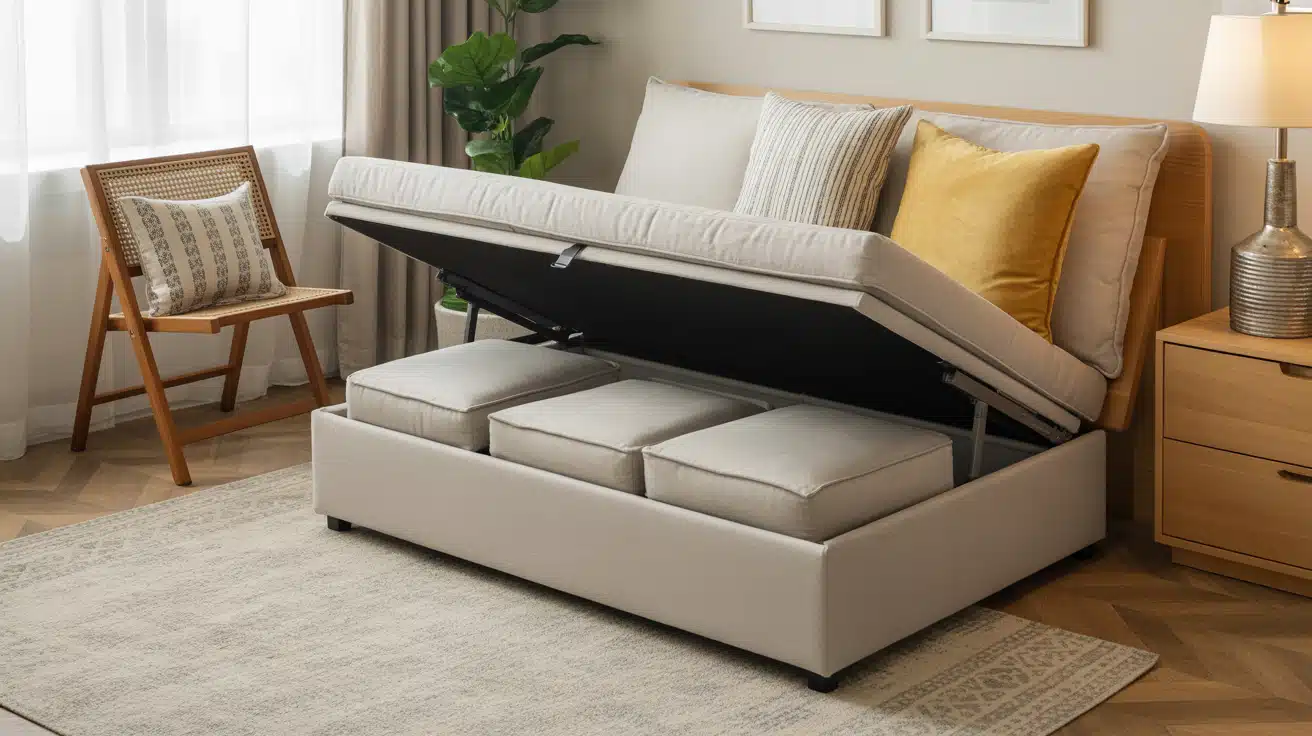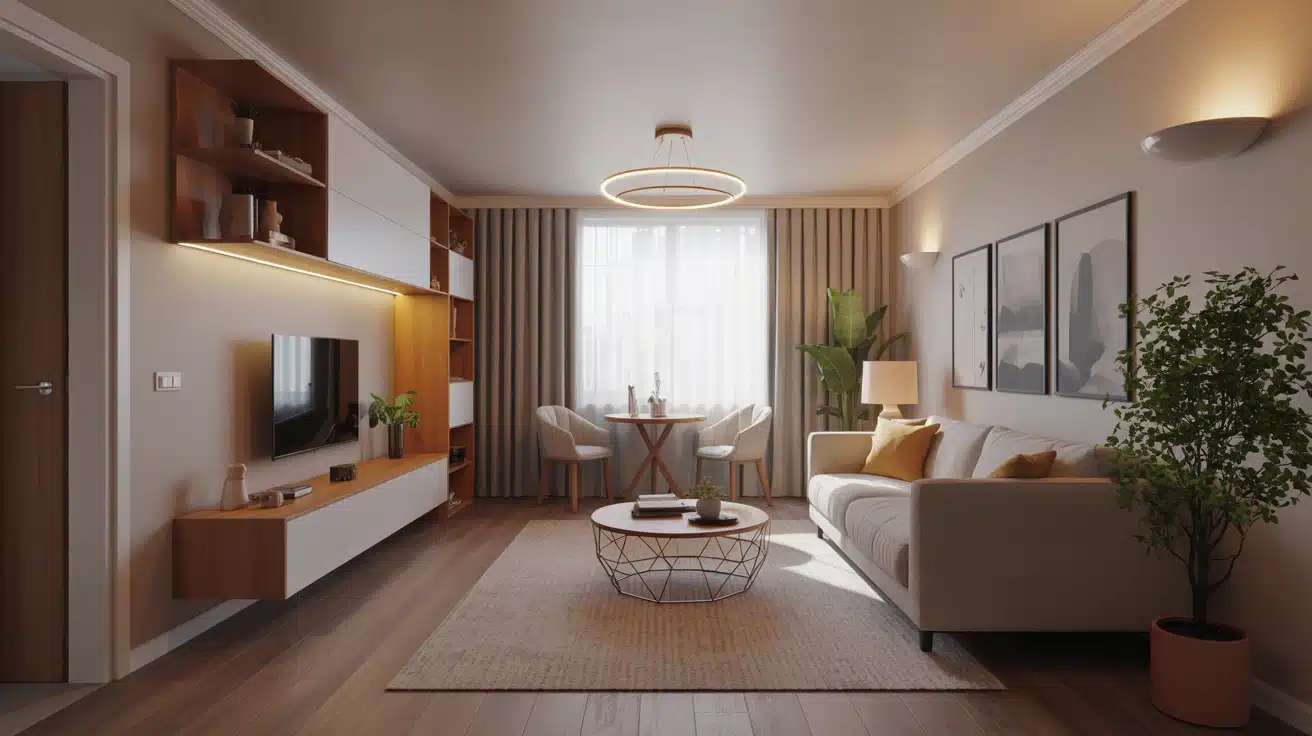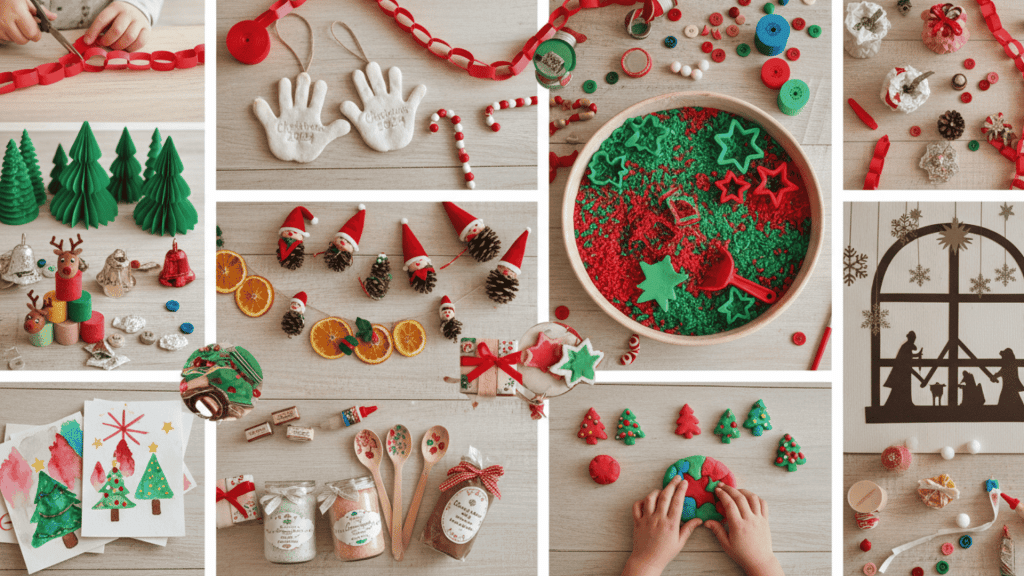Living in a small apartment doesn’t mean sacrificing style or comfort. With the right approach, even tiny spaces can become functional and beautiful homes that reflect your personality.
The key to successful small apartment decorating lies in smart planning and creative solutions.
You need to think about every square inch and make pieces work double duty.
From choosing the right colors to picking multi-functional furniture, these strategies help create spaces that feel much larger than their actual footprint.
This guide reveals proven small apartment decorating tips that interior designers use to maximize both style and function.
Whether you have a studio or a cramped one-bedroom, these ideas will help you create a home you love without breaking your budget or violating rental restrictions.
Smart Color Schemes That Make Small Apartments Feel Bigger
Color choice is your most powerful tool for creating the illusion of space in compact apartments.
Light and Neutral Base Colors
Light colors reflect more light, making rooms appear larger and brighter. Soft whites, cream, and light gray create an airy foundation that opens up tight spaces.
These neutrals work particularly well on walls because they don’t compete with furniture or artwork for attention.
Consider warm whites instead of stark whites for a more inviting feel. Colors like ivory, bone, or off-white add subtle warmth without closing in the space.
Light gray offers more personality than white while maintaining the space-expanding effect.
Strategic Use of Bold Accents
While light colors should dominate, strategic pops of bold color add personality and visual interest. Deep blues, rich burgundy, or forest green can anchor a room when used sparingly in pillows, artwork, or a single accent wall.
The 60-30-10 rule works well in small apartments: 60% neutral base color, 30% secondary color, and 10% bold accent color.
Jewel tones like sapphire, emerald, and amethyst reflect 2025 trends and add luxury to small spaces when used in small doses.
Multi-Functional Furniture Solutions
Every piece of furniture in a small apartment should serve at least two purposes to maximize both style and storage.
1. Storage Ottomans and Benches
Storage ottomans serve triple duty as seating, footrests, and hidden storage containers.
Look for rectangular ottomans that can hold magazines, blankets, or out-of-season clothing. Leather and fabric options blend seamlessly with various design styles, providing both aesthetic appeal and practical benefits.
Bench seating with storage underneath works particularly well in entryways or at the foot of beds. These pieces can hold shoes, linens, or cleaning supplies while also providing extra seating for guests.
2. Expandable and Folding Tables
Drop-leaf tables offer a full dining surface when needed, but fold down to a console table width for everyday use. This solution works perfectly for studio apartments where dining and living areas overlap.
Wall-mounted folding desks create temporary work surfaces without permanently claiming floor space. Nesting tables stack together when not in use, but provide multiple surface options for entertaining or daily activities.
3. Sofa Beds and Daybeds
Modern sofa beds have improved dramatically from bulky pull-out models. Look for designs with memory foam mattresses and streamlined mechanisms that don’t require removing cushions.
Daybeds work particularly well in studio apartments because they serve as intentional seating during the day. Add plenty of pillows and a throw to make them feel like a couch for daily use.
Maximizing Vertical Space and Wall Storage
When floor space is limited, thinking vertically opens up countless storage and decorating opportunities.
1. Floor-to-Ceiling Shelving
Tall, narrow bookcases draw the eye upward, making ceilings appear higher while providing substantial storage. Choose units that nearly reach the ceiling for maximum impact and storage capacity.
Ladder-style shelving takes up minimal floor space while offering multiple display and storage levels. These pieces work well for books, plants, and decorative objects without feeling heavy in small rooms.
2. Wall-Mounted Solutions
Floating shelves provide storage without the visual bulk of traditional bookcases. Install them at varying heights to create visual interest while accommodating different storage needs.
Wall-mounted desks fold down when needed and disappear against the wall when not in use.
Pegboard systems provide customizable storage solutions for kitchens, bedrooms, and entryways, with modern versions available in a range of colors.
3. Over-Door Storage
Over-door organizers work on bedroom, bathroom, and closet doors to maximize storage without using wall space. Choose clear or matching colors to maintain visual cohesion.
Over-door mirrors serve dual purposes by providing full-length reflection while making spaces appear larger. Some models include jewelry storage or small shelving.
Strategic Lighting to Create Depth and Warmth
Proper lighting can make the difference between a cramped feeling space and one that feels open and inviting.
Layered Lighting Approach
Multiple light sources at different heights create depth and prevent the flat, cramped feeling that single overhead lights can create. Combine table lamps, floor lamps, and wall sconces for comprehensive illumination.
Ambient, task, and accent lighting each serve different purposes in small apartments. Ambient lighting provides overall illumination, task lighting supports activities, and accent lighting highlights architectural features or artwork.
Space-Enhancing Light Fixtures
Wall-mounted sconces free up table surfaces while providing targeted lighting for reading or tasks. Swing-arm models offer adjustability without requiring additional floor space.
LED strip lighting under cabinets or behind TVs adds ambient glow that makes spaces feel larger while providing functional task lighting. Light-colored window treatments reflect rather than absorb natural light.
Creating Zones in Open Floor Plans
Even studio apartments can feel like multi-room homes with strategic zoning techniques that don’t require walls.
Room Dividers That Don’t Block Light
Open shelving units separate spaces while maintaining visual flow and allowing light to pass through. Choose designs with geometric patterns or staggered shelves for added visual interest.
Area rugs define separate zones without physical barriers. Use different rug styles, colors, or textures to clearly delineate living, dining, and sleeping areas. Curtain dividers offer flexible separation that can be opened or closed as needed.
Furniture Placement for Flow
Back-to-back seating arrangements create natural divisions between living and dining areas while maintaining conversation flow. A console table behind a sofa provides additional surface and storage.
Angled furniture placement breaks up the square, boxy feeling that can plague small apartments. Position seating at slight angles to create more organic traffic patterns.
Budget-Friendly Decorating Ideas
Style doesn’t have to break the bank, especially with these cost-effective solutions perfect for small apartments.
DIY Projects That Make a Big Impact
Removable wallpaper allows for a transformation of rental walls without making permanent changes. Current options include sophisticated patterns that rival traditional wallpaper in appearance.
Gallery walls featuring personal photos create custom art installations at a minimal cost. Mix frame styles and sizes for visual interest, but maintain consistent spacing for professional results.
Plant propagation allows you to fill your apartment with greenery for the cost of a few parent plants. Pothos, snake plants, and philodendrons propagate easily and thrive indoors.
Rental-Friendly Updates
Command strips and adhesive hooks allow wall decorations without nail holes. Current versions hold substantial weight and remove cleanly.
Temporary backsplash tiles update kitchens and bathrooms with peel-and-stick options that look like real tile or natural stone. Contact paper treatments can transform cabinet fronts or create faux marble countertops for minimal investment.
Common Mistakes to Avoid
Learning from these frequent decorating errors will save you time, money, and frustration in your small apartment.
Furniture Scale Errors
Oversized furniture can make small apartments feel cramped and impede traffic flow. Measure carefully and consider apartment-scaled versions of standard pieces.
Too many small pieces can make spaces feel cluttered and busy. Better to have fewer, well-chosen pieces that serve multiple functions. Blocking natural light with tall furniture near windows reduces the space-expanding effects of natural illumination.
Storage and Organization Blunders
Visible clutter destroys the clean lines needed for small apartments to feel spacious. Invest in closed storage solutions and establish regular decluttering habits.
Underutilizing vertical space misses major storage opportunities. Look for solutions before expanding outward into the living space.
Conclusion
Small apartment decorating doesn’t mean sacrificing style or functionality. With thoughtful planning and creative solutions, your compact space can feel both spacious and personal.
The key lies in choosing pieces that work harder, using color strategically, and maximizing every available inch.
Remember that small apartment decorating tips are most effective when applied systematically.
Start with one area, apply these principles consistently, and build from there. Focus on solutions that align with your lifestyle and budget constraints.
Your small apartment can be just as stylish and comfortable as any larger home.
By emphasizing multi-functional furniture, strategic color choices, and smart storage solutions, you create a space that truly feels like home, regardless of size.







































